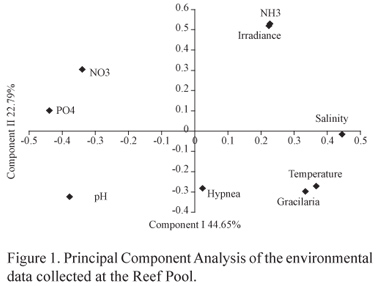The diversity of algal banks composed of species out the genera Gracilaria Greville and Hypnea J.V. Lamouroux have been impacted by commercial exploitation and coastal eutrophication. The present study sought to construct dynamic models based on algal physiology to simulate seasonal variations in the biomasses of Gracilaria and Hypnea an intertidal reef at Piedade Beach in Jaboatão dos Guararapes, Pernambuco State, Brazil. Five 20 × 20 cm plots in a reef pool on a midlittoral reef platform were randomly sampled during April, June, August, October, and December/2009 and in January and March/2010. Water temperature, pH, irradiance, oxygen and salinity levels as well as the concentrations of ammonia, nitrate and phosphate were measured at the sampling site. Forcing functions were employed in the model to represent abiotic factors, and algal decay was simulated with a dispersal function. Algal growth was modeled using a logistic function and was found to be sensitive to temperature and salinity. Maximum absorption rates of ammonia and phosphate were higher in Hypnea than in Gracilaria, indicating that the former takes up nutrients more efficiently at higher concentrations. Gracilaria biomass peaked at approximately 120 g (dry weight m-2) in March/2010 and was significantly lower in August/2009; Hypnea biomasses, on the other hand, did not show any significant variations among the different months, indicating that resource competition may influence the productivity of these algae.
algal biomass; eutrophication; sandstone reefs; trophic models


















